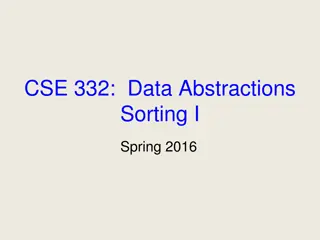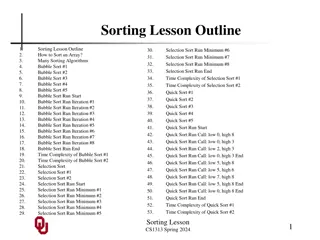
Sorting Methods in Python
Explore the differences between sorted() and sort() functions in Python, learn how to use sort key for custom sorting, and discover how to sort lists by last names. Dive into examples and explanations to enhance your understanding of sorting techniques in Python programming.
Download Presentation

Please find below an Image/Link to download the presentation.
The content on the website is provided AS IS for your information and personal use only. It may not be sold, licensed, or shared on other websites without obtaining consent from the author. If you encounter any issues during the download, it is possible that the publisher has removed the file from their server.
You are allowed to download the files provided on this website for personal or commercial use, subject to the condition that they are used lawfully. All files are the property of their respective owners.
The content on the website is provided AS IS for your information and personal use only. It may not be sold, licensed, or shared on other websites without obtaining consent from the author.
E N D
Presentation Transcript
Sorting UW CSE 160 1
sorted vs. sort sorted(itr) - is a function that takes an iterable as a parameter (e.g. sequence types: list, string, tuple) and returns a sorted version of that parameter lst.sort - is a method that sorts the list that it is called on in-place (and returns None). .sort can only be called on lists my_lst = [5, 3, 4, 2] print (sorted(my_lst)) print (my_lst) Returns a new sorted list [2, 3, 4, 5] [5, 3, 4, 2] Does not modify original list my_lst.sort() print (my_lst) [2, 3, 4, 5] Modifies the list in place, returns None 2
See in python tutor sorted vs. sort example hamlet = "to be or not to be that is the question whether tis nobler in the mind to suffer".split() Returns a new sorted list (does not modify the original list) print ("hamlet:", hamlet) print ("sorted(hamlet):", sorted(hamlet)) print ("hamlet:", hamlet) print ("hamlet.sort():", hamlet.sort()) print ("hamlet:", hamlet) Modifies the list in place, returns None Lists are mutable they can be changed including by functions 3
See in python tutor Customizing the sort order Goal: sort a list of names by last name names = ["Isaac Newton", "Albert Einstein", "Niels Bohr", "Marie Curie", "Charles Darwin", "Louis Pasteur", "Galileo Galilei", "Margaret Mead"] print ("names:", names) This does not work: print ("sorted(names):", sorted(names)) When sorting, how should we compare these names? "Niels Bohr" "Charles Darwin" 4
See in python tutor Sort key A sort key is a function that can be called on each list element to extract/create a value that will be used to make comparisons. We can use this to sort on a value (e.g. last_name ) other than the actual list element (e.g. first_name last_name ). We could use the following function as a sort key to help us sort by last names: def last_name(str): return str.split(" ")[1] print('last_name("Isaac Newton"):', last_name("Isaac Newton")) 5
See in python tutor Use a sort key as the key argument Supply the key argument to the sorted function or the sort function def last_name(str): return str.split(" ")[1] names = ["Isaac Newton", "Ada Lovelace", "Fig Newton", "Grace Hopper"] print (sorted(names, key=last_name)) print (sorted(names, key=len)) If there is a tie in last names, preserves original order of values. def last_name_len(name): return len(last_name(name)) print (sorted(names, key=last_name_len)) 6
See in python tutor itemgetter is a function that returns a function Useful for creating a function that will return particular elements from a sequence (e.g. list, string, tuple): Call function passing in this list as an argument Returns a function import operator 8 7 3 (7, 3) operator.itemgetter(2)([7, 3, 8]) operator.itemgetter(0)([7, 3, 8]) operator.itemgetter(1)([7, 3, 8]) operator.itemgetter(0, 1)([7, 3, 8]) operator.itemgetter(3)([7, 3, 8]) IndexError: list index out of range A tuple 7
See in python tutor Itemgetter Example import operator Call function passing in this string as an argument Returns a function operator.itemgetter(2, 7, 9, 10)("dumbstricken") operator.itemgetter(2, 5, 7, 9)("homesickness") operator.itemgetter(2, 7, 9, 10)("pumpernickel") operator.itemgetter(2, 3, 6, 7)("seminaked") operator.itemgetter(1, 2, 4, 5)("smirker") # Could even return elements in a different order operator.itemgetter(9, 7, 6, 1)("beatnikism") operator.itemgetter(14, 13, 5, 1)("Gedankenexperiment") operator.itemgetter(12, 10, 9, 5)("mountebankism") 8
Two ways to Import itemgetter A tuple import operator student_score = ('Robert', 8) operator.itemgetter(0)(student_score) Robert operator.itemgetter(1)(student_score) 8 Or Another way to import, allows you to call itemgetter directly. from operator import itemgetter student_score = ('Robert', 8) itemgetter(0)(student_score) Robert itemgetter(1)(student_score) 8 9
See in python tutor Using itemgetter Another way to import, allows you to call itemgetter directly. from operator import itemgetter student_score = ('Robert', 8) itemgetter(0)(student_score) Robert itemgetter(1)(student_score) 8 student_scores = [('Robert', 8), ('Alice', 9), ('Tina', 7)] Sort the list by name: sorted(student_scores, key=itemgetter(0)) Sort the list by score sorted(student_scores, key=itemgetter(1)) 10
See in python tutor Sorting based on two criteria Goal: sort based on score; if there is a tie within score, sort by name Two approaches: Approach #1: Use an itemgetter with two arguments Approach #2: Sort twice (most important sort last) student_scores = [('Robert', 8), ('Alice', 9), ('Tina', 10), ('James', 8)] Approach #1: sorted(student_scores, key=itemgetter(1,0)) Approach #2: sorted_by_name = sorted(student_scores, key=itemgetter(0)) sorted_by_score = sorted(sorted_by_name, key=temgetter(1)) 11
Sort on most important criteria LAST Sorted by score (ascending), when there is a tie on score, sort using name from operator import itemgetter student_scores = [('Robert', 8), ('Alice', 9), ('Tina', 10), ('James', 8)] sorted_by_name = sorted(student_scores, key=itemgetter(0)) >>> sorted_by_name [('Alice', 9), ('James', 8), ('Robert', 8), ('Tina', 10)] sorted_by_score = sorted(sorted_by_name, key=itemgetter(1)) >>> sorted_by_score [('James', 8), ('Robert', 8), ('Alice', 9), ('Tina', 10)] 12
See in python tutor More sorting based on two criteria If you want to sort different criteria in different directions, you must use multiple calls to sortor sorted student_scores = [('Robert', 8), ('Alice', 9), \ ('Tina', 10), ('James', 8)] Goal: sort score from highest to lowest; if there is a tie within score, sort by name alphabetically (= lowest to highest) sorted_by_name = sorted(student_scores, key=itemgetter(0)) sorted_by_hi_score = sorted(sorted_by_name, key=itemgetter(1), reverse=True) 13 Remember: Sort on most important criteria LAST
Digression: Lexicographic Order 'Aaron' 'Andrew' 'Angie' [1, 9, 9] [2, 1] [3] 'with' 'withhold' 'withholding' [1] [1, 1] [1, 1, 1] 'Able' 'Charlie' 'baker' 'delta' [1, 1] [1, 1, 2] [1, 2] 14
Sorting: strings vs. numbers Sorting the powers of 5: >>> sorted([125, 5, 3125, 625, 25]) [5, 25, 125, 625, 3125] >>> sorted(["125", "5", "3125", "625", "25"]) ['125', '25', '3125', '5', '625'] 15
See in python tutor Aside: Use a sort key to create a new list Create a different list that contains the value returned by the sort key, sort it, then extract the relevant part: names = ["Isaac Newton", "Fig Newton", "Niels Bohr"] # keyed_names is a list of [lastname, fullname] lists keyed_names = [] for name in names: keyed_names.append([last_name(name), name]) 1) Create the new list. 2) Sort the list new list. If there is a tie in last names, sort by next item in list: fullname sorted_keyed_names = sorted(keyed_names) sorted_names = [] for keyed_name in sorted_keyed_names: sorted_names.append(keyed_name[1]) print ("sorted_names:", sorted_names) 3) Extract the relevant part. 16






















